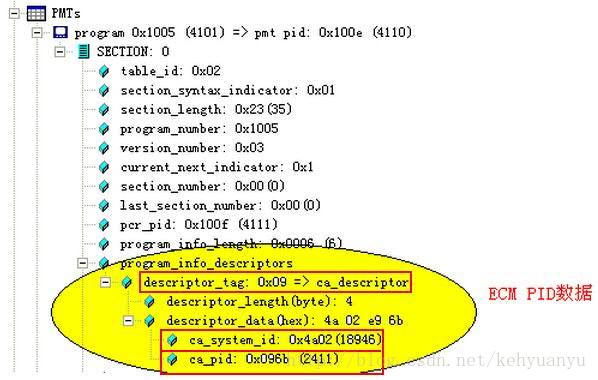CAT表中EMM PID 和 PMT表中ECM 的解析
直播中播放加扰节目时,常常启动播放流程(申请设备链,tuner,demux,audio decoder ,video decoder)之后,通常画面还是不能出来的。此时需要我设置当前节目的EMM PID,ECM PID到CA里面。解扰的大致流程是,第三方CA收到EMM PID之后,利用智能卡中的中固化的PDK(中间件层密钥)从EMM中解出 业务密钥SK ,然后在利用业务密钥从解出对应的ECM PID中解出对应的控制字CW ,最后将得到的控制字设置到解码芯片相应的寄存器即可完整解扰。
另外需要普及一下,ECM 控制加扰的信息可以是节目级别,也可以是流级别,也就是program level 或者是es level 级别,es 流可以是音频的,视频的,或者其他类型,也就是说可以整体加扰控制,也可以分开控制一个节目音频,视频等等。
借用网上剪辑的图加以说明:
对于CA厂商来说,通常只会提供几个接口给STB厂商来设置EMM PID ,CA system ID, ECM PID ,Service ID,当然这些参数也会根据大厂商定制化的需要发生一些变动。
EMM ,ECM ,CA system ID数据的来源
EMM ,ECM ,CA system ID 存在于CAT,PMT两个表中,这两个表一般都是通过设置filter向驱动请求CAT 表和对应PMT表,有个相同点是,这些信息都存在于CA_descriptor() 的描述字段中。
ca 描述字段的结构如下:
解析的代码如下:
BOOL ca_descriptor_parse(BYTE* buf , int nlength,int *pnCAsysID ,int *pnEcmpid)
{
int ndescriptor = 0;
int ndes_length = 0;
int nCASystemID = 0;
int nelementPID = 0;
BYTE *pByte = NULL;
if(buf == NULL || nlength <= 0)
{
printf("param error!\n");
return FALSE;
}
pByte = buf;
while(nlength > 0)
{
ndescriptor = pByte[0];
ndes_length = pByte[1];
if(ndescriptor == 0x09)
{
nCASystemID = (pByte[3]<<8 | pByte[4]);
// nelementPID = ((pByte[5]&0x1f)<<8 | pByte[6]);
nelementPID = (pByte[5]<<8 | pByte[6]) & 0x1fff ;
}
*pnCAsysID = nCASystemID;
*pnEcmpid = nelementPID;
nlength -= ndes_length;
printf("CA system ID : %d ,ECM/EMM PID : %d",nCASystemID ,nelementPID);
}
return TRUE;
}
CA_system_ID :表示适用于相关ECM和EMM流的相关的CA系统类型(CA厂家标识符)。
CA_PID : PMT表中的该描述信息为ECM的PID,CAT 表中的该描述信息为EMM的PID。
ca_descriptor描述符的值是0x09,也即descriptor_tag 的值,如图:
CAT:
PMT:
ECM 的解析
结合上面两张图来看,解析代码如下:
BOOL ECMParse(BYTE* pBuf , int nLen )
{
int nTableID = 0;
int nSectionLen = 0;
int nServiceID = 0;
int nProgramLen = 0;
if(pBuf == NULL || nLen < 12 || nLen > 4096)
{
printf("param error!\n");
return FALSE;
}
nTableID = pBuf[0];
if(nTableID != 0x02)
{
printf("The Table is not PMT table!\n");
return FALSE;
}
nSectionLen = ((pBuf[1]&0x0f) << 8 )| pBuf[2];
// nSectionLen = ((pBuf[1]<< 8 )| pBuf[2])& 0x0fff;
if(nLen != nSectionLen + 3 )
{
printf("section error!\n");
return FALSE;
}
nServiceID = (pBuf[3] << 8) | pBuf[4];// program number
pBuf = pBuf + 10 // move pointer to the second reserved field
nLen = nLen - 10;
nProgramLen = ((pBuf[0]&0x0f) << 8 |pBuf[1]);// get the program info length
if(nProgramLen + 7 >= nSectionLen)
{
printf("Bad Data!\n");
return FALSE;
}
pBuf = pBuf + nProgramLen;// move the pointer to the CA descriptor field
nLen = nLen - nProgramLen;
// TS level ecm parse
int nTSCasysID = 0;
int nTSEcmPID = 0;
int noffest = //the offest to the global ca_descriptor field
ca_descriptor_parse(pBuf+noffest , nLen-noffest ,&nTSCasysID , &nTSEcmPID);
//program level ecm parse
while(nLen >5) // make sure the ca_descriptor have data
{
int eStreamType = 0;
int nEsPid = 0;
int nESInfoLen = 0;
int nLength = 0;
int nCAsysID = 0;
int nEcmPid = 0;
eStreamType = pBuf[0];
nEsPid = ((pBuf[1]&0x1f << 8) | pBuf[2]); // es stream pid ,audio pid ,video pid and so on
nLength = (((pcData[3] & 0x0F) << 8) | pcData[4]);
if(wDiscriptorLen > nLen -5)
{
printf("data error!\n");
return FALSE;
}
pBuf = pBuf + 5; // move the pointer to the ca_descriptor field
nLen = nLen - 5;
ca_descriptor_parse(pBuf,nLen,&nCAsysID,&nEcmPid);
}
return TRUE;
}
CAT表中的EMM解析比较简单就不作解释了。
以上解析动作尽量不要在播放过程中去请求,会消耗一定的时间,如果在播放之前解析好缓存起来,对直播速度会有一定的优化作用。


